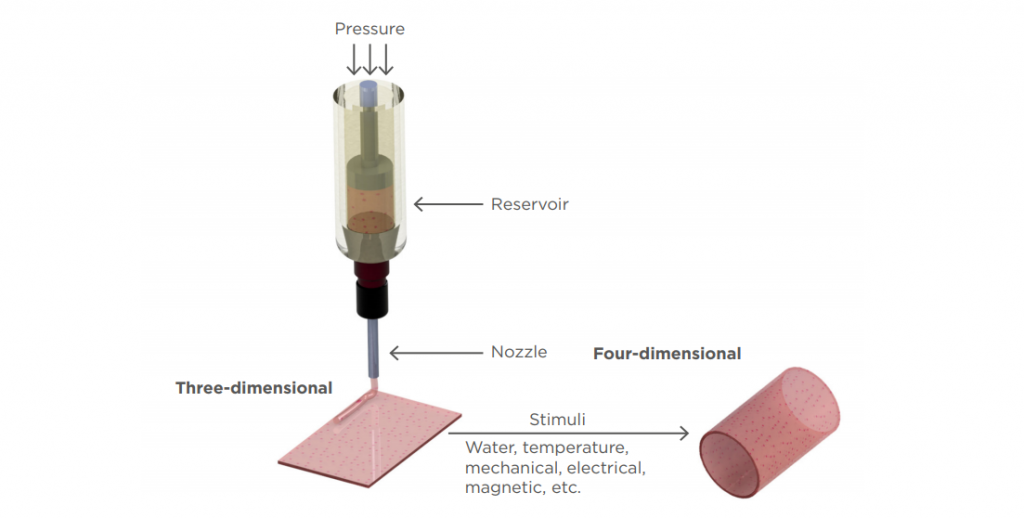 3D printing has been progressing rapid-speed over the past few years, with numerous forays to the next level into 4D printing, whether in serious world-changing endeavors or those that are creative and sometimes even whimsical, such as fashion. Now, researchers see that 4D advancements in bioprinting may trickle down to doctor’s offices too. Authors Pedro Morouço and João Gil of Biofabrication RDi Group, Centre for Rapid and Sustainable Product Development at Polytechnic Institute of Leiria (Portugal) expand on their findings in Four-Dimensional Bioprinting for Regenerative Medicine: Mechanisms to Induce Shape Variation and Potential Applications.
3D printing has been progressing rapid-speed over the past few years, with numerous forays to the next level into 4D printing, whether in serious world-changing endeavors or those that are creative and sometimes even whimsical, such as fashion. Now, researchers see that 4D advancements in bioprinting may trickle down to doctor’s offices too. Authors Pedro Morouço and João Gil of Biofabrication RDi Group, Centre for Rapid and Sustainable Product Development at Polytechnic Institute of Leiria (Portugal) expand on their findings in Four-Dimensional Bioprinting for Regenerative Medicine: Mechanisms to Induce Shape Variation and Potential Applications.
Regenerative medicine is a central focus in bioprinting as researchers around the world try to overcome the challenges of sustaining living tissue in the lab. The end goal, the holy grail of bioprinting, will be to eventually fabricate human organs in the lab—or perhaps even in clinical practice—meaning the elimination of donor lists, organ rejection, and failing quality of life for a multitude of patients globally.
“Regenerative engineering has come to be considered an inevitability and a promising approach for the regeneration of tissues or organs by culturing patient cells into biological substitutes (scaffolds) and subsequent implantation into the patient for the regeneration of new tissue,” state the researchers, pointing out that scaffolds can be made through both conventional and newer techniques—both offering a list of pros and cons.
The team leans toward using 3D printing and venturing into the 4D however, pointing out the potential for greater strides in medicine and tissue regeneration, with so much more control over pore size, shape, and interconnectivity. With 4D printing, researchers can move beyond the restrictions of implants unable to transform according to their biological environment.

Illustrative representation of the transformation from three-dimensional to four-dimensional bioprinting,
which can be triggered by different types of stimuli.
“The potential of 3D printing enhanced by a fourth dimension makes it possible to contribute significantly to the bioprinting of engineered tissues, such as the liver and heart, which will represent a major breakthrough in the area of regenerative medicine,” state the researchers.
Bioinks are commonly used in fabricating viable cells, but they must meet certain criteria for success and researchers must navigate fragility to temperature as well as peripheral chemicals, stress, and issues like UV light exposure. Significant progress has been made with ‘smart materials’ also, namely with bioprinting and some level of shape-morphing. And while creating patient-specific organs may seem to be right around the corner, the research team points out that there is still much progress to be made in creating human tissue structures in the lab.
“The interdisciplinary combination of life sciences with engineering is demonstrating noteworthy advances for healthcare,” conclude the researchers. “Although 3D bioprinting has opened minds to biofabrication, the absence of response to planned stimuli should be considered. However, it does provide an appropriate tool to create hybrid, versatile, and functional tissue constructs; thus, coupling biofabrication with stimuli-responsive materials, novel maturation processes, and validation procedures will bring us one step closer to successful regenerative medicine.”
What do you think of this news? Let us know your thoughts! Join the discussion of this and other 3D printing topics at 3DPrintBoard.com.
[Source / Images: Four-Dimensional Bioprinting for Regenerative Medicine: Mechanisms to Induce Shape Variation and Potential Applications]
Subscribe to Our Email Newsletter
Stay up-to-date on all the latest news from the 3D printing industry and receive information and offers from third party vendors.
Print Services
Upload your 3D Models and get them printed quickly and efficiently.
You May Also Like
Consolidation in AM: How 2025 Is Shaping the Industry’s New Normal
The first half of 2025 has been marked by a clear shift in the additive manufacturing (AM) industry. Companies are no longer just focused on developing new tech by themselves....
Etsy Design Rule Change Reduces Selection of 3D Printed Goods
Online marketplace Etsy has implemented a rule change requiring all 3D printed goods on the site to be original designs. The update to the site’s Creativity Standards states, ¨Items produced using...
U.S. Congress Calls Out 3D Printing in Proposal for Commercial Reserve Manufacturing Network
Last week, the U.S. House of Representatives’ Appropriations Committee moved the FY 2026 defense bill forward to the House floor. Included in the legislation is a $131 million proposal for...
Transforming From Tourist to Native: Duro CEO Michael Corr Explains Why the Company Rebuilt its PLM Software on AI
In these early innings of the AI boom, many market analysts have expressed concern that AI spend has gotten too far ahead of the technology’s proven ability to deliver significant...

































